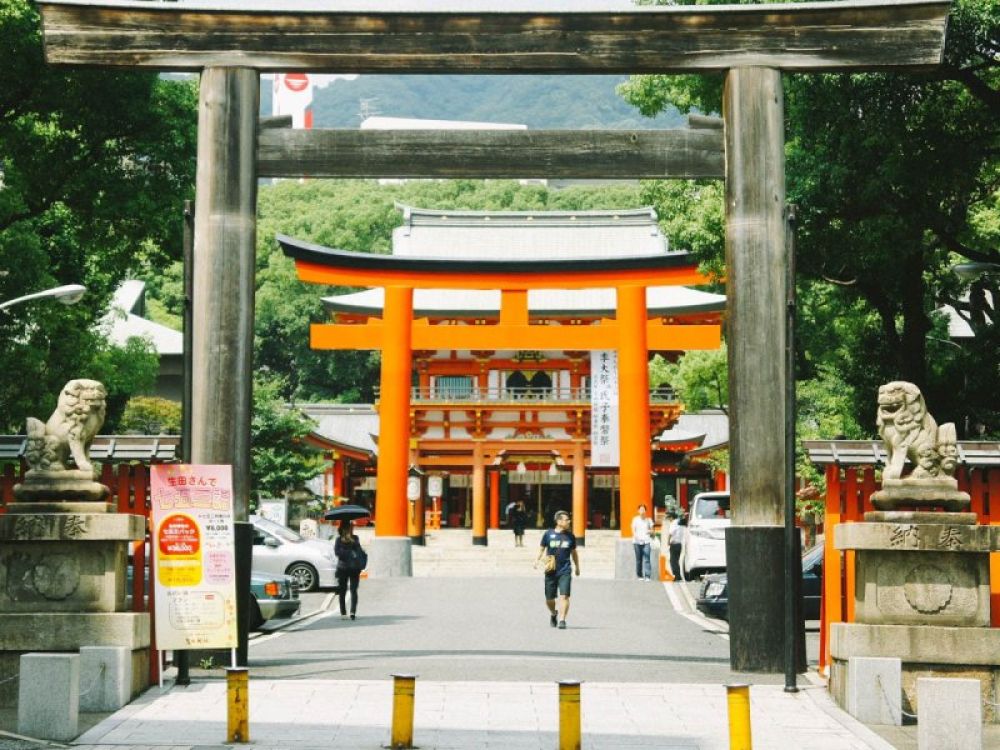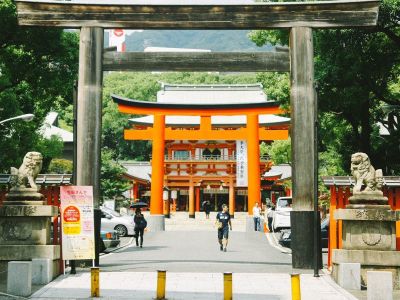

Ikuta Shrine, nestled in the heart of Kobe, is a sanctum of serenity and a place of rich history. Reported to have been established over 1800 years ago, it stands as one of the oldest Shinto shrines in Japan. Visitors are welcomed by the large torii gate, which marks the entrance into a space that is both spiritual and historical. As you step through the threshold, you enter a realm where ancient traditions are preserved and celebrated. The main hall, or Honden, is an architectural marvel, where visitors can pay their respects, offer prayers, and soak in the tranquil ambiance. Throughout the year, the shrine hosts various festivals and ceremonial events, providing a glimpse into Shinto practices and Japanese culture. Engaging with local worshippers and observing the rituals firsthand fosters a deep connection with the traditions that have shaped the Japanese way of life for centuries.
One of the more personal and reflective activities at Ikuta Shrine is writing wishes on Ema, which are small wooden plaques. Visitors partake in this tradition by purchasing an Ema at the shrine, and then inscribing their wishes, hopes, or prayers onto the wood. After writing their messages, participants hang the plaques on designated areas within the shrine grounds for the deities to receive them. This practice is deeply rooted in Shinto belief, which holds that deities can intercede in one's life. Engaging in this activity offers individuals a moment of introspection and a unique way to articulate their aspirations. It is quite touching to see the diverse range of wishes hanging side by side, symbolizing the shared hopes and dreams of humanity. Ema writing is a must-do for those seeking to experience a tangible connection to Japan's spiritual culture.
Seasonal festivals, or 'matsuri,' are vibrant and integral aspects of life at Ikuta Shrine. These events draw crowds from far and wide, eager to partake in the festivities. Each festival has its own unique characteristics, often celebrating the change of seasons, historical events, or expressing gratitude to the deities. Attendees can witness elaborate processions, traditional music, and dance performances that fill the air with a palpable energy. Typical features of these festivals include food stalls offering local delicacies, crafts, and games that create a carnival-like atmosphere, perfect for families and travelers alike. Participating in a matsuri at Ikuta Shrine is an unforgettable experience that will give you a deeper appreciation of Japan's communal spirit and its dedication to preserving time-honored traditions.
For those curious about their future, Omikuji fortune telling provides an intriguing glimpse at what may lie ahead. Upon visiting Ikuta Shrine, patrons can partake in this popular practice by purchasing an Omikuji - a strip of paper upon which one's fortune is inscribed. Fortunes range from great luck to great misfortune, covering various aspects of life such as health, love, and business. After receiving their Omikuji, visitors often tie them onto designated frames or trees within the shrine grounds, especially if the fortune is less than favorable, as a gesture of leaving the bad luck behind. Engaging with Omikuji is not only a fun activity but also a window into the Japanese mindset of honoring the forces that shape their lives, while always hoping for a brighter future.
Ikuta Shrine offers a picturesque setting for photography enthusiasts and sightseers. With its rich history and beautiful structures like the main hall, torii gates, and traditional lanterns, the shrine presents a plethora of photo opportunities. Visitors can capture the beauty of the vermilion lacquered buildings contrasted against the natural surroundings. The lush greenery and the flowing waters of the nearby Ikuta River add to the serene landscape, making it an ideal spot for landscape and wildlife photography. Besides structural beauty, capturing moments of tranquility and the daily activities of worshippers and Shinto priests can make for compelling photographs. Sightseers will also enjoy the peaceful walkways lined with trees, creating an escape from the hustle and bustle of Kobe city life.
Goshuin collecting is a captivating activity for culture enthusiasts and pilgrims visiting Japanese shrines and temples. At Ikuta Shrine, visitors can bring their 'Goshuin-cho,' a special book, and receive a Goshuin: a unique stamp or calligraphy inscription provided at the shrine. Each Goshuien reflects the character of the temple or shrine and is considered a sacred memento of one's visit. The practice involves Holy communion with the shrine's deity, and obtaining the Goshuin is sometimes accompanied by a small ritual. Collectors treasure these stamps, not only as souvenirs but as spiritual symbols of their journey through Japan's religious sites. Goshuin collecting at Ikuta Shrine is an engaging way to commemorate your visit and partake in a tradition that dates back centuries.
The grounds of Ikuta Shrine serve as a beautiful canvas for various seasonal flowers blooming throughout the year. Depending on the season, visitors can indulge in the sights of sakura (cherry blossoms), ume (plum blossoms), irises, and other captivating flora. Sakura season, in particular, is a splendid time for 'hanami,' the traditional Japanese activity of flower viewing. Families and groups of friends gather under the blooming trees for picnics and socializing, embracing the transient beauty of the blossoms. The sight of delicate pink petals fluttering gently in the breeze against the backdrop of the shrine's architectural beauty creates a moment of pure aesthetic delight. The practice of flower viewing at Ikuta Shrine is a celebration of nature, beauty, and the changing seasons, offering visitors a peaceful reprieve from their daily routine.
Participating in a traditional Japanese tea ceremony is a serene activity that visitors can experience in the vicinity of Ikuta Shrine. Although the shrine itself may not offer a tea ceremony every day, various cultural centers and tea houses nearby do host these events. The ceremony, known as 'sado' or 'chanoyu,' is a choreographed ritual of preparing and serving matcha, or powdered green tea. It embodies the concepts of harmony, respect, purity, and tranquility, which are central to Japanese culture. During the ceremony, guests are guided through the proper etiquette of receiving and enjoying the tea, often accompanied by traditional sweets. This cultural immersion provides insight into the aesthetic and philosophical ideals that are integral to the Japanese way of life.
Ikuta Shrine periodically hosts various cultural workshops and classes that allow participants to delve deeper into Japanese traditions. These educational experiences can range from ikebana (flower arranging) to calligraphy, to learning about Shinto music and dance. Each class offers a hands-on approach to understanding Japanese culture, engaging visitors in the ancient arts that are quintessential expressions of Japan's heritage. Under the guidance of skilled practitioners, guests can create their own floral masterpiece or practice the fluid art of Japanese character writing. The workshops often include a discussion about the historical and philosophical significance of the practices, providing a richer, fuller understanding of their place in Japanese society. These activities are ideal for those looking to expand their cultural horizons while visiting the shrine.
The New Year, or 'Sh?gatsu,' is one of the biggest celebrations at Ikuta Shrine, where throngs of visitors come to participate in 'Hatsumode,' the first shrine visit of the year. This annual tradition is a major event, with locals and tourists alike seeking blessings for good luck and prosperity in the upcoming year. As midnight approaches on December 31st, the countdown begins, and people join in the jubilant atmosphere, often enjoying 'toshikoshi soba,' noodles eaten to usher in the new year. The shrine is adorned with festive decorations, and the air is filled with the sounds of bells and joyous greetings. Amulets and talismans for the new year are also popular items for visitors to purchase. New Year's celebrations at Ikuta Shrine provide a special opportunity for reflection and hope for the future, amidst a community of shared cultural heritage.
